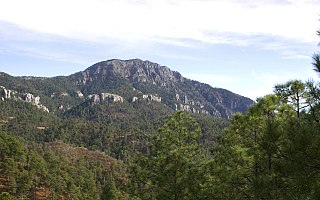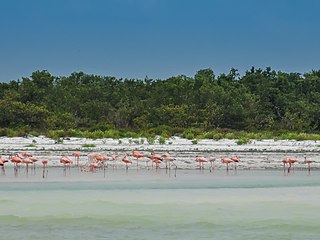 W
WThe Cascadas de Agua Azul are a series of waterfalls found on the Xanil River in the southern Mexican state of Chiapas. They are located in the Municipality of Tumbalá, 69 kilometres (43 mi) from Palenque, near Mexican Federal Highway 199.
 W
WThe Cañón de Santa Elena Flora and Fauna Protection Area is a protected area for plants and wildlife in the Mexican municipalities of Manuel Benavides and Ojinaga, in the state of Chihuahua. It was founded on November 7, 1994 and has an area of 277,209 hectares.
 W
WCerro Mohinora is an extinct volcano that is part of the Sierra Madre Occidental mountain range in the Mexican state of Chihuahua located in the municipality of Guadalupe y Calvo. Cerro Mohinora is the highest point in the state of Chihuahua reaching an elevation of 10,827 ft above sea level. The climate of the mountain is extremely cold in the winter and temperate to semi-cold in the summer.
 W
WCuatro Ciénegas is a city in the northern Mexican state of Coahuila. It stands at 26°59′N 102°03′W, at an average elevation of 740 metres (2,430 ft) above sea level. The city serves as the municipal seat for the surrounding municipality of the same name.
 W
WLaguna de Términos is the largest and one of biologically the richest tidal lagoons located entirely on the Gulf Coast of Mexico, as measured by water volume. Exchanging water with several rivers and lagoons, the Laguna is part of the most important hydrographic river basin in Mexico. It is important commercially, as well as ecologically by serving as a refuge for an extensive number of flora and fauna; its mangroves provide an important role as a refuge for migratory birds.
 W
WThe Samalayuca Dune Fields, more traditionally known as Los Medanos, or more recently referenced as Medanos de Samalayuca are a series of large but separated fields of sand dunes located in the northern part of the Mexican state of Chihuahua. The dune fields are scattered over a wide expanse of desert to the south, southwest and southeast of Ciudad Juárez. The dune fields are located in a 2000 km2 area known as the Samalayuca Desert.
 W
WYum Balam Flora and Fauna Protection Area is a Mexican Flora and Fauna Protection Area located in the state of Quintana Roo in southeastern Mexico. Established in 1994, the nature reserve was the first protected area in Mexico to be created at the request of local communities. The reserve includes wetlands along the north shore of the Yucatán Peninsula and adjacent Isla Holbox and has been designated as a protected Ramsar site since 2004.